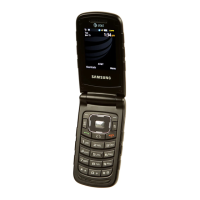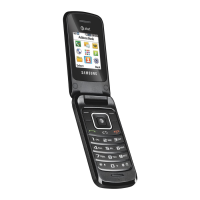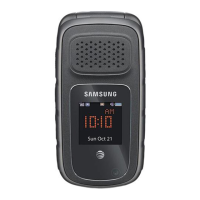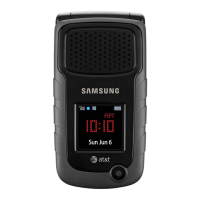Do you have a question about the Samsung SGH SGH A300 and is the answer not in the manual?
Follow safety guidelines for driving, refueling, and air travel.
Adhere to regulations, understand interference, and use qualified service.
Tips for sensible usage and procedures for emergency calls.
List of items included in the phone package.
Diagram and explanation of the phone's physical components.
Description of the phone's display areas and icons.
Information on display backlight and service light functionality.
Details on the phone's external display features.
Step-by-step guide for making your first phone call.
Instructions for correctly inserting the SIM card into the phone.
Procedure for charging the phone's battery.
How to turn the phone on and off.
Understanding the low battery warning message and its implications.
Explanation of phone and SIM card security codes.
Details on Personal Identification Number (PIN) and PUK codes.
Information on PIN2 and call barring password.
Instructions for making standard and international calls.
Adjusting volume, answering/ending calls, and call holding.
Making calls using the phonebook and redialing numbers.
How to view, edit, or delete missed call entries.
How to view and select functions/options using soft keys.
Step-by-step guide to changing the phone's display language.
How to store names and numbers in the phonebook.
Using memory locations for quick dialing.
Finding and calling numbers from the phonebook.
Accessing and using options like Edit, Erase, Copy, and Caller Groups.
Checking phonebook memory and Service Dialling Numbers (SDN).
Overview of T9, Upper/Lower-case, and Number input modes.
How to switch between different text input modes.
Guide to using the T9 predictive text input method.
Instructions for entering text using multi-tap character modes.
How to enter numbers using the dedicated number mode.
Placing calls on hold and temporarily muting the microphone.
Manage key tones, access phonebook, use SMS, and answer second calls.
Setting up and managing conference calls.
How to use navigation keys to move through menus.
Using hierarchical numbers to directly access menu options.
Overview of the phone's menu structure and options.
Accessing missed, received, and dialled call records.
Checking call duration for last call, total sent, and total received.
Viewing call costs, setting maximum cost, and resetting counters.
Accessing and viewing received messages in inbox and outbox.
Composing and sending text messages.
Creating and using pre-written messages.
Configuring SMS settings like service centre and message type.
Receiving and managing text messages on various topics.
Accessing and managing voice mailbox features.
Customize ring tones, melodies, and ring volume.
Configure alert types and various notification tones.
Set call duration alerts and connection confirmation tones.
Sending/receiving data via the infrared port.
Setting a custom message displayed on startup.
Managing and viewing your own phone numbers.
Adjusting display language and screen backlight.
Configuring automatic redial and answering calls by opening flip.
Customizing call answering and LCD contrast.
Restoring the phone to its default configuration.
Consulting, writing, and editing memos and calendar entries.
Creating and managing tasks with priorities and deadlines.
Setting current time, date, and checking world time.
Setting and managing alarms, including autopower.
Using the phone as a basic calculator.
Assigning menu options to navigation and C keys.
Enabling PIN check and changing your PIN.
Locking the phone with a password.
Changing phone password and locking the SIM card.
Using Fixed Dial Number mode and changing PIN2.
Setting up call rerouting based on conditions.
Restricting outgoing and incoming calls.
Being informed of incoming calls during an active call.
Automatically or manually selecting networks when roaming.
Managing display of your number to the called party.
Restricting calls to specific user groups.
Using the phone's WAP browser to access the internet.
Basic troubleshooting steps for common phone issues.
Understanding error messages like 'No service' or 'Not done'.
Troubleshooting problems with dialling, receiving, or hearing calls.
Resolving low battery warnings and poor call audio quality.
Troubleshooting problems recalling numbers from the phonebook.
Guidelines for safe and effective battery usage and charging.
Safety guidelines related to using the phone while driving.
Recommendations for safe phone usage in various environments.
Tips for keeping the phone and accessories in good condition.
Important notes and limitations regarding emergency calls.
Definitions of key terms like DCS, GSM, PIN, PUK, Roaming, SDN.
Definitions of more technical terms and abbreviations.
| Network | GSM 900 / 1800 |
|---|---|
| SIM | Mini-SIM |
| Loudspeaker | No |
| 3.5mm jack | No |
| Games | Yes |
| Talk time | Up to 3 h |
| Internal Memory | No |
| Alert types | Vibration |
| Messaging | SMS |
| Languages | Multiple |
| Colors | Silver |
| Battery Type | Li-Ion 800 mAh battery |












